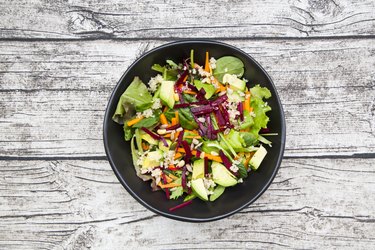
There's no clear link between old lettuce and food poisoning, but don't eat lettuce that is slimy, smelly or past its expiration date — eating expired food can make you sick. If you're extremely worried about foodborne illnesses, skip raw greens and thoroughly cook all the produce you consume.
Tip
Lettuce that is past its expiration date, wilted, slimy or bad-smelling should be tossed, as eating expired foods can make you unwell. If it doesn't look right, don't eat it.
Video of the Day
If you eat a lot of lettuce, try to stay up-to-date on recalls issued by the Food and Drug Administration (FDA). These happen occasionally due to concerns about harmful bacteria contaminating lettuce from a certain farm, brand or geographic area.
Video of the Day
Eating Lettuce and Food Safety
According to the Centers for Disease Control and Prevention, raw lettuce and sprouts are common sources of E. coli, a bacteria that causes food poisoning. Common symptoms of E. coli infection include diarrhea, severe stomach cramps, vomiting and fever. People usually develop symptoms three or four days after consuming a contaminated food, and feel better within five to seven days.
You can reduce your risk of developing foodborne illnesses by following the FDA's food safety guidelines. Be sure to keep your hands, utensils and food prep surfaces clean. Always rinse fresh fruits and vegetables under running water, and use a clean brush to scrub produce.
Another important food safety rule is to keep raw meat and seafood away from fresh produce, especially anything you plan to eat without cooking first. Ensure your food is properly stored, with raw meat and seafood in leakproof containers to avoid contamination.
Brown Lettuce and Food Poisoning
Experts say there's no direct link between brown lettuce and food poisoning risks. Berkeley Wellness explains that lettuce leaves can turn brown when they have been bruised or cut because exposure to air triggers oxidation. According to the University of California Statewide IPM Program, another cause of lettuce browning is tipburn, usually linked to rapid growth or soil water stress.
Brown or black spots on lettuce could also be caused by a process called russet spotting. This happens when lettuce is exposed to low concentrations of ethylene, a plant hormone that's released as a gas. This ethylene exposure triggers the production of phenolic compounds, causing those brown or black spots on lettuce.
Luckily, russet spotting is purely a cosmetic issue. However, if the brown or black spots on lettuce are accompanied by a strange smell or texture that makes you think the issue is not just russet spotting, it's best to toss out that lettuce rather than eating it.
What About Pink Lettuce?
Pink lettuce is linked to something called pink rib, which is when the "ribs" of lettuce heads turn from white to pink. This can happen when the lettuce is "overmature" or stored at high temperatures, a study published in Euphytica in August 2017 explains. Pink lettuce can be eaten safely, provided the greens are still fresh.
If at any point your lettuce changes color and that worries you, just throw the salad leaves away. You can add the lettuce to your compost pile to reduce your kitchen waste.
- Centers for Disease Control and Prevention: "Food Poisoning Symptoms"
- Food and Drug Administration: "Safe Food Handling"
- Berkeley Wellness: "Ask the Experts: Brown Lettuce"
- University of California Statewide IPM Program: "Tipburn"
- Euphytica: "Oxidative Discolouration in Whole-Head and Cut Lettuce: Biochemical and Environmental Influences on a Complex Phenotype and Potential Breeding Strategies to Improve Shelf-Life"
- Food and Drug Administration: "Recalls, Market Withdrawals, & Safety Alerts"